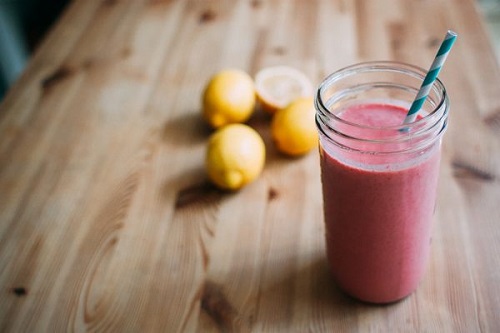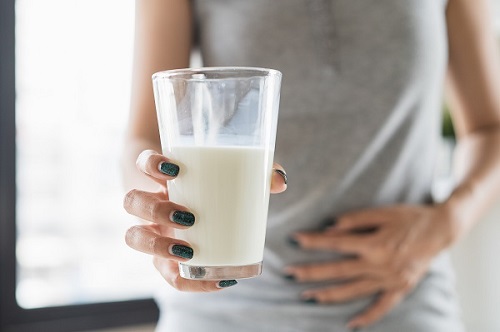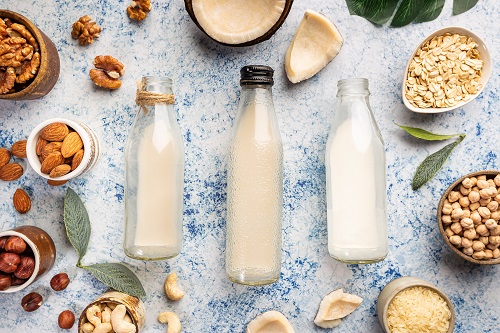Milk is an affordable source of protein, vitamins, and minerals. We’re diving into the benefits of milk, why some people feel sick after drinking it, and options for similar nutrient-rich drinks and food!
Benefits of Milk
Milk is an easy and convenient option for getting in a lot of nutrition. Some of the health benefits include:
Nutrient packed!
- Milk contains an easily absorbed form of protein, calcium, vitamin D, B vitamins, phosphorus, potassium, and more. This means that our bodies don’t waste a thing!
- Did you know? Milk is the main way that Americans get calcium! [1]
Good for strong bones and muscles!
- With 8 grams of high–quality protein per cup, milk builds and maintains strong bones and muscles for children, adults, and seniors. It is a nutrient powerhouse!
Reduces risk of disease!
- Low-fat milk helps to lower blood pressure and risk of diabetes.
- The calcium, vitamin D, and phosphorus in milk also slow bone loss that happens as we get older.
- For more on changes in bones as we age, check out our Healthy Aging and Bones blog. [1]

Get all the benefits!
UGA SNAP-Ed has some delicious recipes that contain milk:
- If you’re looking for something to sip on, try our Pumpkin Spice Latte or Homemade Hot Chocolate—yummy year-round! For something fruity, how about our Strawberry Smoothie?
- Banana Pudding Overnight Oats make for a calcium-rich breakfast!
- If dessert pudding is your thing, try our Creamy Pineapple Pudding and Amazing Banana Pudding.

Dairy Difficulties
Some people have stomach pain or other bad symptoms after drinking milk. If you have experienced this, you are not alone! There are a couple reasons that this can happen:
1. Lactose Intolerance:
- If you have uncomfortable side effects after drinking milk, you might be “intolerant” to milk. Luckily, the symptoms will pass and are not life-threatening!
- A lactose intolerance is when your stomach has trouble breaking down the sugar, called lactose, in milk and other milk products. [2]
- Taking a lactase pill or choosing products that are “lactose-free” will help ease or prevent the discomfort. Hard cheeses like cheddar, parmesan, and swiss, and Greek yogurt have less lactose, too!
2. Dairy Allergy:
- This is an immune response to the protein in milk and other dairy products. It means that the immune system attacks itself because it thinks there is an intruder.
- Very bad reactions can occur, including anaphylaxis. It can be life-threatening. If you think you have an allergy to dairy, visit a doctor to be diagnosed safely. [3]
- Non-dairy drinks are safest for people with a dairy allergy.

What’s in your Glass?
The refrigerated section of the grocery store has so many milk and non-dairy milks to choose from. They all cost different amounts and have different labels about who knows what! With all these options, it gets confusing. Let’s break down some of the most popular ones:
Cow’s Milk
- This is the “gold standard” for nutrition because of how easily absorbed the nutrients are
- Does contain dairy
- Comes in whole, reduced (2%), low (1%), and fat-free options
- Costs about 2-cents per fluid ounce (16-cents per cup)–that is less than $3 a gallon!
Lactose free milk
- Contains the same nutrition as cow’s milk and contains dairy
- It has the enzyme needed to digest the lactose sugars—no stomach pain!
- Costs about 5-cents per fluid ounce (40-cents per cup)
Soy milk
- Closest nutrition to cow’s milk
- Soy is recommended by the Dietary Guidelines for Americans as the best milk substitute for children and adults (talk to your doctor to discuss the best and safest option for your family) [1]
- Comes sweetened, unsweetened, and flavored
- Costs about 4-cents per fluid ounce (32-cents per cup)
Almond/Nut Milk
- Protein and nutrients added (check the label!)
- Does contain nut allergens!
- Comes sweetened, unsweetened, and flavored
- Costs about 5-cents per fluid ounce (40-cents per cup)
Rice Milk
- Low in protein and naturally sweet
- Usually allergen-free because rice is free of most allergens
- Comes flavored or unsweetened
- Costs about 6-cents per fluid ounce (48-cents per cup)
Oat Milk
- Protein and sugar are added (check the label!)
- Contains oats, which may contain gluten depending on where they are grown
- Comes flavored or unflavored
- Costs about 8-cents per fluid ounce (64-cents per cup)
Hemp Milk
- Nutrients are added (check the label!)
- May contain gluten
- Comes sweetened, unsweetened, and flavored
- Costs about 11-cents per fluid ounce (88-cents per cup)
Coconut Milk
- Nutrients are added (check the label!)
- Comes sweetened, unsweetened, and flavored
- Costs about 8-cents per fluid ounce (64-cents per cup)

Non-dairy drinks provide different levels of nutrients compared to the typical cow’s milk. The table below shows how non-dairy milks stack up to dairy milk!
| Nutrients
(based on 1 cup) |
Cow’s Milk | Soy Milk | Almond Milk | Rice Milk | Oat Milk | Hemp Milk | Coconut Milk |
| Calories | 105 | 110 | 60 | 120 | 120 | 140 | 70 |
| Protein (grams) | 8 | 8 | 1 | 1 | 3 | 4 | 0 |
| Added Sugar (grams) | 0 | 5 | 7 | 0 | 7 | 12 | 7 |
| Calcium (% DV) | 25% | 30% | 30% | 30% | 25% | 20% | 10% |
| Vitamin D (% DV) | 10% | 15% | 10% | 25% | 20% | 10% | 10% |
Source: Most affordable options in ‘original’ flavors of each drink from Kroger.com
Keep in mind that calcium and vitamin D can be added to both dairy and non-dairy milks! You may notice that these nutrients are sometimes added to the milk at higher levels than what is naturally found in dairy milk. This is because the nutrients are not absorbed into our bodies as easily as when they exist naturally in dairy milk.
If added sugar is something you are watching, read the label to help you choose the best option. Sugar is commonly added for flavor in many non-dairy milks, and the amount may not be the same as the table above.
Still “Meh” for Milk?
If you don’t like drinking milk but want the benefits of dairy, try mixing milk into other foods (like pudding, oatmeal, and smoothies). For similar nutrients, opt for other dairy products like yogurt and cheese! [4] Be sure to talk with a doctor if you have young kids who are not drinking milk.

Read the nutrition facts label of non-dairy milk options to look at the nutrition content. Then, eat a variety of foods to fill in the nutrients you might be missing. This may include protein, fat, calcium, and vitamin D. [1] [2]
Protein foods include:
- Meat, poultry, seafood, eggs
- Soy products like tofu and soybeans
- Beans, peas, and lentils
- Nuts and seeds
Calcium can be found in:
- “Calcium-fortified” items like cereal, juice, and non-dairy drinks
- Canned fish (with the bones)
- Soy products, beans, and some nuts
- Leafy greens and broccoli
Vitamin D is in the following:
- Fatty fish like salmon
- Eggs
- Fortified 100% juice
- And we make some in our skin when we go out in the sun.
Bottom Line
Milk is an easy and affordable way to get in a lot of nutrients that support strong muscles, bones, and more! If you are not consuming milk, you have options! Eat a variety of foods that include protein, calcium, and vitamin D to make sure you are not missing any nutrients.
Written by Melanie Ng, PhD Student | Edited by Leslie Davis, MS, RDN, LD, CDCES and the Nutrition Education Team
Posted: Feb. 8, 2021
[2] EatRight.org – Lactose Intolerance